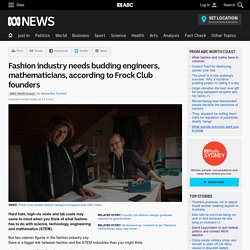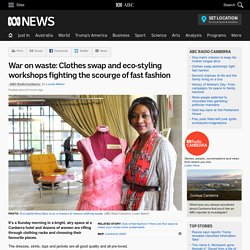

Choli - fabrics international. Description : A tightly fitted, short blouse that ends just below the bust worn under a sari.

It is either long sleeved, short sleeved or sleeveless. Common to India and other parts of Asia.Subtypes :Parts :Preferred fabrics : cotton, silk, rayon, satin, etc.Construction : The choli is cut to fit tightly to the body and has short sleeves and a low neck. The choli is usually cropped, allowing exposure of the navel. The fabric is darted around the bust to ensure a close fit (such as under the arms and downwards).Saris are often woven with an extra length of material meant to be cut off and fashioned into a matching choli. The choli may be sewn so that the elaborately woven borders of the sari material form the bottom edges of the choli sleeves.
Fashion industry needs budding engineers, mathematicians, according to Frock Club founders. Updated earlier today at 12:51amMon 7 Jan 2019, 12:51am Hard hats, high-vis vests and lab coats may come to mind when you think of what fashion has to do with science, technology, engineering and mathematics (STEM).

But two veteran figures in the fashion industry say there is a bigger link between fashion and the STEM industries than you might think. Lois Hennes and Ruth Povall say just like architecture and engineering, fashion can involve maths and critical thinking. As two of Australia's leading pattern engineers, a role that involves building models for manufacturing prototypes, the women are on a mission to encourage bright minds to consider jobs in fashion, rather than pursuing stereotypical STEM careers.
They have created a group called Frock Club to tackle what they say are frivolous perceptions of fashion. "The fashion industry has a lot to offer, it's not just clothing," Ms Hennes said. Inspiring young people Don't be fooled by social media While you're here… are you feeling curious? War on waste: Clothes swap and eco-styling workshops fighting the scourge of fast fashion. Posted It's a Sunday morning in a bright, airy space at a Canberra hotel and dozens of women are rifling through clothing racks and choosing their favourite pieces.

The dresses, skirts, tops and jackets are all good quality and all pre-loved. And the women — some op shop veterans, some novices — are all warriors in the war against fast fashion. Fast fashion is the term that describes the quick turnover of trendy, cheaply made clothing that often ends up in landfill. "The reason we do these clothes swaps is not only to have fun and tszuj up our wardrobes," said Nina Gbor, eco-stylist and event organiser. "It's basically to reduce clothing waste. " Exploring the potential of second-hand clothes Ms Gbor holds clothes swap and style workshops several times a year, motivated by her belief in sustainability and love of fashion. How Well Do You Know Sewing Terms? - Zoo. Sewing for the Instagram Generation. But the energetic Ms.

Cafaro may be better suited to the more wide-ranging job of creative director. “I have the attention span of a gnat,” she said. She started in the industry in the late 1970s, selling Vogue Patterns in Bloomingdale’s, and she remembers with fondness the luxe days, when she and her colleagues traveled to Europe to meet with designers. “We would take 10- to 12-day trips to Paris, London, Milan,” she said. “Life was good.”
Part of the goal of posting the archive images, said Ms. Ms. Another blogger turned designer, who works for the McCall’s line, is Nikki Brooks-Revis, 36. Ms. Sewing patterns were, in a sense, the original fast fashion: a quick, affordable, stylish option before the advent of the $20 H & M dress. “It was called the Walkaway dress because you could sit down at a sewing machine in the morning and walk away wearing it to lunch,” Ms. How To Make Naturally Dyed Easter Eggs. Easter without Easter eggs is unthinkable for many, but how can we add a planet-strong element to the celebrations?

When it comes to colouring your Easter Eggs this year (organic and free-range ones we hope), AVOID food colouring kits at all costs, which contain undesirable chemicals. Although one artificially dyed egg is unlikely to harm you, why even risk it when it's so easy to colour your Easter eggs naturally using homemade plant-based dyes? Spinach, beetroots, turmeric, paprika, blueberries and red cabbage can all create beautiful spring colours that take to egg shells without affecting the edible part of the eggs. Before we had artificial dyes, people only used natural ones to change the colours of objects, so lets return to this age-old tradition that's better for our health and the environment. RELATED: Say 'No' to Egg-cessive packaging this Easter!
Home page - Clothing Production Toolbox Series 5. Fashion Industry. Environmental Studies: Recycle, Reuse & Repurpose. Fashion, Textiles and Society. Costume and Set Design. Fashion Design & Illustration. Interior Design. Topics for Discussion.